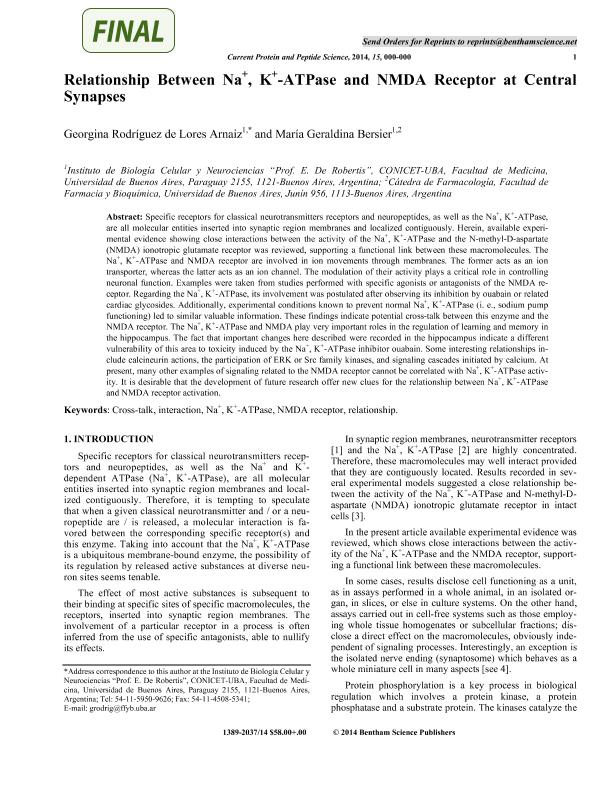Mostrar el registro sencillo del ítem
dc.contributor.author
Rodriguez, Georgina Emma

dc.contributor.author
Bersier, Maria Geraldina

dc.date.available
2017-05-26T20:24:46Z
dc.date.issued
2014-08
dc.identifier.citation
Rodriguez, Georgina Emma; Bersier, Maria Geraldina; Relationship between Na+, K+-ATPase and NMDA receptor at central synapses; Bentham Science Publishers; Current Protein and Peptide Science; 15; 8; 8-2014; 761-777
dc.identifier.issn
1389-2037
dc.identifier.uri
http://hdl.handle.net/11336/17002
dc.description.abstract
Specific receptors for classical neurotransmitters and neuropeptides, as well as the Na+, K+-ATPase, are all molecular entities inserted into synaptic region membranes and localized contiguously. Herein, available experimental evidence showing close interactions between the activity of the Na+, K+-ATPase and the N-methyl-D-aspartate (NMDA) ionotropic glutamate receptor was reviewed, supporting a functional link between these macromolecules. The Na+, K+- ATPase and NMDA receptor are involved in ion movements through membranes. The former acts as an ion transporter, whereas the latter acts as an ion channel. The modulation of their activity plays a critical role in controlling neuronal function. Examples were taken from studies performed with specific agonists or antagonists of the NMDA receptor. Regarding the Na+, K+-ATPase, its involvement was postulated after observing its inhibition by ouabain or related cardiac glycosides. Additionally, experimental conditions known to prevent normal Na+, K+-ATPase (i. e., sodium pump functioning) led to similar valuable information. These findings indicate potential cross-talk between this enzyme and the NMDA receptor. The Na+, K+-ATPase and NMDA play very important roles in the regulation of learning and memory in the hippocampus. The fact that important changes here described were recorded in the hippocampus indicate a different vulnerability of this area to toxicity induced by the Na+, K+-ATPase inhibitor ouabain. Some interesting relationships include calcineurin actions, the participation of ERK or Src family kinases, and signaling cascades initiated by calcium. At present, many other examples of signaling related to the NMDA receptor cannot be correlated with Na+, K+-ATPase activity. It is desirable that the development of future research offer new clues for the relationship between Na+, K+-ATPase and NMDA receptor activation.
dc.format
application/pdf
dc.language.iso
eng
dc.publisher
Bentham Science Publishers

dc.rights
info:eu-repo/semantics/openAccess
dc.rights.uri
https://creativecommons.org/licenses/by-nc-sa/2.5/ar/
dc.subject
Na+
dc.subject
Nmda Receptor
dc.subject
Central Synapses
dc.subject
Cross-Talk
dc.subject
K+-Atpase
dc.subject
Relationship
dc.subject.classification
Neurociencias

dc.subject.classification
Medicina Básica

dc.subject.classification
CIENCIAS MÉDICAS Y DE LA SALUD

dc.title
Relationship between Na+, K+-ATPase and NMDA receptor at central synapses
dc.type
info:eu-repo/semantics/article
dc.type
info:ar-repo/semantics/artículo
dc.type
info:eu-repo/semantics/publishedVersion
dc.date.updated
2017-05-26T14:42:33Z
dc.identifier.eissn
1875-5550
dc.journal.volume
15
dc.journal.number
8
dc.journal.pagination
761-777
dc.journal.pais
Emiratos Árabes Unidos

dc.journal.ciudad
Sharjah
dc.description.fil
Fil: Rodriguez, Georgina Emma. Consejo Nacional de Investigaciones Científicas y Técnicas. Oficina de Coordinación Administrativa Houssay. Instituto de Biología Celular y Neurociencia "Prof. Eduardo de Robertis". Universidad de Buenos Aires. Facultad de Medicina. Instituto de Biología Celular y Neurociencia ; Argentina
dc.description.fil
Fil: Bersier, Maria Geraldina. Consejo Nacional de Investigaciones Científicas y Técnicas. Oficina de Coordinación Administrativa Houssay. Instituto de Biología Celular y Neurociencia "Prof. Eduardo de Robertis". Universidad de Buenos Aires. Facultad de Medicina. Instituto de Biología Celular y Neurociencia ; Argentina. Universidad de Buenos Aires. Facultad de Farmacia y Bioquímica. Departamento de Farmacología. Cátedra de Farmacología; Argentina
dc.journal.title
Current Protein and Peptide Science

dc.relation.alternativeid
info:eu-repo/semantics/altIdentifier/doi/http://dx.doi.org/10.2174/1389203715666140903145608
dc.relation.alternativeid
info:eu-repo/semantics/altIdentifier/url/http://www.eurekaselect.com/124350/article
Archivos asociados
